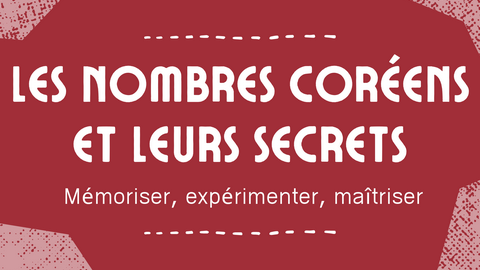Cours de coréen ᚛ Level 1 - My First Steps in Korean (Lessons 1 to 30) ᚛ Leçon 1 - Learn Hangul (part 1) - Simple vowels
Learn Hangul (part 1) - Simple vowels
Learning Hangeul
List of Simple Vowels in Korean
Hangeul is made up of 10 simple vowels.
ㅏ
The vowel ㅏ is pronounced [a], like in the word “car”.
ㅑ
The vowel ㅑ is pronounced [ya], like in the word “yard”.
ㅓ
The vowel ㅓ is pronounced as an open [o] sound, like in the word “onion”.
ㅕ
The vowel ㅕ is pronounced as an open [yo] sound, like in “young”.
ㅗ
The vowel ㅗ is pronounced as a closed [o] sound, like in the word "old".
It’s important to distinguish
ㅗ from
ㅓ, as they are two different sounds that create different words.
ㅓ is an open [o] like in “onion”, while ㅗ is a closed [o] like in “old”.
ㅛ
The vowel ㅛ is pronounced as a closed [yo] sound, like in the word "yoga".
Again, be careful to distinguish
ㅛ from
ㅕ.
ㅕ is an open [yo] like in "young", while ㅛ is a closed [yo] like in "yoga".
ㅜ
The vowel ㅜ is pronounced [oo], like in the word "good".
ㅠ
The vowel ㅠ is pronounced [yoo], like in the word "youth".
ㅡ
The vowel ㅡ has no exact equivalent in English. It sounds like the [e] in the word "eaten", but the lips are stretched rather than rounded.
ㅣ
The vowel ㅣ is pronounced [i], like in the word "ill".
Summary Table
|
Jamo |
Pronunciation |
|
ㅏ |
a |
|
ㅑ |
ya |
|
ㅓ |
eo / o (open) |
|
ㅕ |
yeo / yo (open) |
|
ㅗ |
o (closed) |
|
ㅛ |
yo (closed) |
|
ㅜ |
u / oo |
|
ㅠ |
yu / yoo |
|
ㅡ |
eu (with stretched lips) |
|
ㅣ |
i |
Writing Vowel Sounds in Korean
We will look at this in more detail later when we learn how to write syllables in Korean, but actually, it is not possible to write a vowel on its own.
Indeed, in Korean, every syllable begins with a consonant and is followed by a vowel.
So, it makes sense to ask the following question: how do you write the syllable [i] (which can mean, among other things, “a tooth”) when there’s no consonant sound in front of the [i]?
There is actually a silent consonant, meaning a consonant that makes no sound when read: this is ㅇ.
So, the word i cannot simply be written as ㅣ. You must place the consonant ㅇ before the vowel ㅣ. That gives us the word for “tooth”: 이, pronounced [i].
Vertical and Horizontal Vowels
There are two types of simple vowels in Korean:
- Vertical vowels: written top to bottom:ㅏ, ㅑ, ㅓ, ㅕ and ㅣ
- Horizontal vowels: written left to right: ㅗ, ㅛ, ㅜ, ㅠ and ㅡ
Knowing whether a vowel is vertical or horizontal is essential in Korean, because this determines where the vowel is placed in relation to the consonant that comes before it. Specifically:
- If the vowel is vertical, it is placed to the right of the consonant that precedes it
- If the vowel is horizontal, it is placed below the consonant that precedes it
In the example seen in the previous section, the word 이, the vowel ㅣ is placed to the right of the consonant, because it is a vertical vowel.
Let’s now write the word pronounced [o], the number 5. For this, we need the vowel ㅗ and the silent consonant ㅇ. We’ve seen that ㅗ is a horizontal vowel, so it must be written below the consonant that comes before it. Therefore, the word pronounced [o] is written 오.
In summary:
- With vertical vowels: 아, 야, 어, 여, 이
- With horizontal vowels: 오, 요, 우, 유, 으
Exercises
En savoir +
Les nombres font partie des bases indispensables de toute langue, mais en coréen, ils représentent souvent un véritable obstacle. Deux systèmes de nombres coexistent et s’emploient dans des contextes précis qu’il faut connaître. Leur prononciation, influencée par des phénomènes propres au coréen, déroute souvent les apprenants. Et, sans comprendre les classificateurs numériques, il devient impossible d’utiliser correctement les nombres au quotidien : dire son âge, commander des plats, fixer un rendez-vous, indiquer un prix…
La formation Les nombres coréens et leurs secrets vous donne toutes les clés pour surmonter ces difficultés. Vous y apprendrez à distinguer et utiliser les deux systèmes de nombres, à prononcer naturellement grâce aux audios natifs, à employer sans erreur les classificateurs, et à manier les nombres dans des situations concrètes comme l’heure, la date, les quantités ou encore les mathématiques. Des points de culture et anecdotes viennent enrichir le contenu pour rendre l’apprentissage vivant et pertinent.
Pour garantir des résultats durables, 5 modules d’entraînement illimité vous permettent de pratiquer autant que nécessaire, jusqu’à ce que les nombres en coréen deviennent un réflexe !
En savoir +

